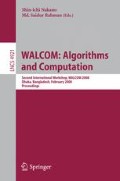Abstract
A packet-switched network is universally stable if, for any greedy protocol and any adversary of injection rate less than 1, the number of packets in the network remains bounded at all times. A natural question that arises is whether there is a fast way to detect if a network is universally stable based on the network’s structure. In this work, we study this question in the context of Adversarial Queueing Theory which assumes that an adversary controls the locations and rates of packet injections and determines packet paths. Within this framework, we present optimal algorithms for detecting the universal stability (packet paths do not contain repeated edges but may contain repeated vertices) and the simple-path universal stability (paths contain neither repeated vertices nor repeated edges) of a network. Additionally, we describe an algorithm which decides in constant time whether the addition of a link in a universally stable network leads it to instability; such an algorithm could be useful in detecting intrusion attacks.
Access this chapter
Tax calculation will be finalised at checkout
Purchases are for personal use only
Preview
Unable to display preview. Download preview PDF.
References
Alvarez, C., Blesa, M., Diaz, J., Fernandez, A., Serna, M.: The Complexity of Deciding Stability under FFS in the Adversarial Model. Information Processing Letters 90, 261–266 (2004)
Alvarez, C., Blesa, M., Serna, M.: A Characterization of Universal Stability in the Adversarial Queuing Model. SIAM Journal on Computing 34, 41–66 (2004)
Andrews, M., Awerbuch, B., Fernandez, A., Kleinberg, J., Leighton, T., Liu, Z.: Universal Stability Results for Greedy Contention-Resolution Protocols. Journal of the ACM 48, 39–69 (2001)
Blesa, M.: Deciding Stability in Packet-Switched FIFO Networks Under the Adversarial Queuing Model in Polynomial Time. In: Fraigniaud, P. (ed.) DISC 2005. LNCS, vol. 3724, pp. 429–441. Springer, Heidelberg (2005)
Borodin, A., Kleinberg, J., Raghavan, P., Sudan, M., Williamson, D.: Adversarial Queueing Theory. Journal of the ACM 48, 13–38 (2001)
Cormen, T.H., Leiserson, C.E., Rivest, R.L., Stein, C.: Introduction to Algorithms, 2nd edn. MIT Press, Cambridge (2001)
Diaz, J., Koukopoulos, D., Nikoletseas, S., Serna, M., Spirakis, P., Thilikos, D.: Stability and Non-Stability of the FIFO Protocol. In: Proc. 13th Annual ACM Symposium on Parallel Algorithms and Architectures, Crete, Greece, pp. 48–52 (2001)
Dong, Y., Rajput, S., Hsu, S.: Application Level Intrusion Detection using Graph-based Sequence Learning Algorithm. In: Proc. IASTED Conference on Modelling and Simulation, Cancun, Mexico (2005)
Garfinkel, S., Spafford, G.: Practical UNIX and Internet Security, 2nd edn. O’Reilly & Associates, Inc. (1996)
Golumbic, M.C.: Algorithmic Graph Theory and Perfect Graphs. Academic Press, New York (1980)
Holm, J., de Lichtenberg, K., Thorup, M.: Poly-logarithmic deterministic fully-dynamic algorithms for connectivity, minimum spanning tree, 2-edge, and biconnectivity. In: Proc. Symposium on Theory of Computing 1998, pp. 79–89 (1998)
Koukopoulos, D., Mavronicolas, M., Nikoletseas, S., Spirakis, P.: The Impact of Network Structure on the Stability of Greedy Protocols. Theory of Computing Systems 38, 425–460 (2005)
Stallings, W.: Network and Internetwork Security Principles and Practice. Prentice-Hall, Englewood Cliffs,NJ (1995)
Author information
Authors and Affiliations
Editor information
Rights and permissions
Copyright information
© 2008 Springer-Verlag Berlin Heidelberg
About this paper
Cite this paper
Koukopoulos, D., Nikolopoulos, S.D., Palios, L., Spirakis, P.G. (2008). Optimal Algorithms for Detecting Network Stability. In: Nakano, Si., Rahman, M.S. (eds) WALCOM: Algorithms and Computation. WALCOM 2008. Lecture Notes in Computer Science, vol 4921. Springer, Berlin, Heidelberg. https://doi.org/10.1007/978-3-540-77891-2_18
Download citation
DOI: https://doi.org/10.1007/978-3-540-77891-2_18
Publisher Name: Springer, Berlin, Heidelberg
Print ISBN: 978-3-540-77890-5
Online ISBN: 978-3-540-77891-2
eBook Packages: Computer ScienceComputer Science (R0)

